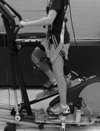Effects of Off-Axis Elliptical Training on Reducing Pain and Improving Knee Function in Individuals With Patellofemoral Pain
- PMID: 25591131
- PMCID: PMC4501904
- DOI: 10.1097/JSM.0000000000000164
Effects of Off-Axis Elliptical Training on Reducing Pain and Improving Knee Function in Individuals With Patellofemoral Pain
Abstract
Objective: To examine whether an off-axis elliptical training program reduces pain and improves knee function in individuals with patellofemoral pain (PFP).
Design: Controlled laboratory study, pretest-posttest.
Setting: University rehabilitation center.
Participants: Twelve adult subjects with PFP.
Interventions: Subjects with PFP completed an exercise program consisting of 18 sessions of lower extremity off-axis training using a custom-made elliptical trainer that allows frontal plane sliding and transverse plane pivoting of the footplates.
Main outcome measures: Changes in knee pain and function posttraining and 6 weeks after training were evaluated using the Knee Injury and Osteoarthritis Outcome Score (KOOS) and International Knee Documentation Committee (IKDC) scores. Lower extremity off-axis control was assessed by pivoting and sliding instability, calculated as the root mean square (RMS) of the footplate pivoting angle and sliding distance during elliptical exercise. Subjects' single-leg hop distance and proprioception in detecting lower extremity pivoting motion were also evaluated.
Results: Subjects reported significantly greater KOOS and IKDC scores (increased by 12-18 points) and hop distance (increased by 0.2 m) after training. A significant decrease in the pivoting and sliding RMS was also observed after training. Additionally, subjects with PFP demonstrated improved pivoting proprioception when tested under a minimum weight-bearing position.
Conclusions: An off-axis elliptical training program was effective in enhancing lower extremity neuromuscular control on the frontal and transverse planes, reducing pain, and improving knee function in persons with PFP.
Clinical relevance: This study provides a novel intervention approach to enhance the control of the frontal and transverse plane motions of the lower extremities during functional weight-bearing activities. This novel off-axis elliptical training may be incorporated with other common treatment options currently available for PFP to augment the effects of musculoskeletal rehabilitation for the PFP population.
Conflict of interest statement
Two authors, Li-Qun Zhang and Yupeng Ren, hold equity positions in Rehabtek LLC, which received funding from the National Science Foundation in developing the off-axis elliptical trainer used in the study.
Figures




References
-
- Davis IS, Powers CM. Patellofemoral pain syndrome: proximal, distal, and local factors, an international retreat. J Orthop Sports Phys Ther. 2010;40:A1–A16. - PubMed
-
- Lankhorst NE, Bierma-Zeinstra SM, van Middelkoop M. Factors associated with patellofemoral pain syndrome: a systematic review. Br J Sports Med. 2013;47:193–206. - PubMed
-
- Fredericson M, Yoon K. Physical examination and patellofemoral pain syndrome. Am J Phys Med Rehabil. 2006;85:234–243. - PubMed
Publication types
MeSH terms
Grants and funding
LinkOut - more resources
Full Text Sources
Medical

